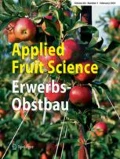Zusammenfassung
Der Artikel beschreibt die Geschichte der 100-jährigen und damit eine der ältesten, weltweit berühmtesten Obstbauforschungsstation aus persönlicher Perspektive. Im März 1913, d. h. vor 100 Jahren, schlossen sich die führenden Obstbauern in der südenglischen Grafschaft Kent zusammen und gründeten die damalige Wye College Fruit Experimental Station. Im Jahre 1920 finanzierte die neu gegründete ‘Kent Incorporated Society for the Promotion of Experiments in Horticulture’ das Forschungslabor in East Malling „mit Büro und Stallungen“, und erwarb als East Malling Research Station ( EMR S ) die Unabhängigkeit von Wye College sowie 9 ha Land als Versuchsfläche.
West – aus der Nachernte-Forschergruppe Kidd und West in Cambridge- startete 1930 im 1929 gegründeten Ditton Laboratory die Postharvestforschung in East Malling und schuf in den 30/40er Jahren die Grundlagen der späteren CA-Lagerung. Im Rahmen der Umstrukturierungen unter Mrs Thatcher wurde die Obstbauforschung in East Malling 1989 mit der Freilandgemüsebauforschung in Wellesbourne und der damaligen Unterglasforschung (Gemüse und Pilze) in Littlehampton zusammengelegt und firmierte zuerst als IHR (Institute of Horticultural Research) und dann als HRI (Horticultural Research International)- zur Bündelung der Expertise in Pflanzenphysiologie, Pflanzenschutz, Pflanzenernährung etc.
So wurde 1982 die Wachstumsregulatorforschung von East Malling nach Long Ashton und die Pflanzenphysiologie nach Wellesbourne verlagert. Im Gegenzug kam nur die Erdbeerzüchtung 1983 von Long Ashton nach East Malling, so dass East Malling aus dieser Umstrukturierung mit einem Defizit an Grundlagenforschung und -forschern endete; parallel dazu wurde die Ribes-Züchtung bzw.- forschung nach Schottland zum SCRI und CAB 1990 nach Wallingford bei Oxford verlagert.
East Malling ist in aller Welt für Sorten und Unterlagen, besonders für die Apfelunterlage M9, die aus Frankreich stammt und in East Malling nur ihren Namen bekam, und das Wurzellabor bekannt. Ken Tobutt züchtete aus den kanadischen Wijciks Klonen die genussfähigen Apfelsorten ‘Maypole’, ‘Bolero’, ‘Waltz’ und ‘Polka’ als Columnar- oder Ballerina Säulenbäume, David Simpson 32 Erdbeersorten und Vicky Knight und Elisabeth Keep 11 Himbeer- (z. B. ‘Autumn Bliss’ und 7 Ribessorten (z. B. ‘Pax’). Die Sparmaßnahmen und Umstrukturierungen haben dazu geführt, dass die englische Gartenbauforschung auf europäischen Gartenbautagungen (SHE in Wien und Angers, EUFRIN – sowie den Orchard Systems und Rootstock-Tagungen) nicht mehr vertreten ist. Auch der Zugang zu den Jahresberichten der EMRS als wertvolle Informationsquelle, die leider nicht online verfügbar sind, ist schwierig.
Seit 2005 ist East Malling wieder selbstständig und fungiert unter dem Namen EMR- East Malling Research, ab 2012 mit neuem Logo mit symbolisierten drei schlanken Obstbaum-Spindeln vor der Sonne.
Abstract
The hundred year history of East Malling Research Station (EMRS) is reviewed from a personal perspective: In March 1913, Kent fruit farmers in the Southeast of England founded the Wye College Fruit Experimental Station. In 1920, the newly formed ‘Kent Incorporated Society for the Promotion of Experiments in Horticulture’ took over East Malling (as a site independent from Wye College) „with offices and horse stables“ and managed 9 ha land provided by Kent County Council (KCC).
West (of the Kidd and West postharvest group at Cambridge) laid the foundations in the 1930/1940s for postharvest research at East Malling Research Station (EMR S) and CA storage in the Ditton Laboratory, founded in 1929 and later merged with EMRS in the 1970s. Under Mrs Thatcher’s ruling, EMRS was merged in 1989 with the National Vegetable Research Station (NVRS) at Wellesbourne (Warwickshire) and the Glasshouse Crops Research Institute (GCRI) in Littlehampton (Sussex) initially as IHR (Institute of Horticultural Research) and then as HRI (Horticultural Research International) to combine the expertise in e.g. plant physiology, plant nutrition, plant growth regulators, plant protection, breeding and molecular biology, a decision regretted when GCRI closed in 1995 and a minority was transferred from GCRI to Wellesbourne. Plant growth regulator research was moved from East Malling to Long Ashton in 1982, whereas strawberry breeding was transferred from Long Ashton to East Malling in 1983, while Ribes breeding transferred to the Scottish Crops Research Institute (SCRI) in Dundee and CAB in 1990 to Wallingford/Oxon. East Malling is famous for its rootstocks, above all M 9, which curiously originated from France, but was selected and named in East Malling. Columnar dessert apple varieties such as ‘Maypole’, ‘Bolero’, ‘Waltz’ and ‘Polka’ (derived from the Canadian Wijcik clones) were bred at East Malling by Ken Tobutt, 32 strawberry varieties by David Simpson, 11 raspberry culivars like ‘Autumn Bliss’ and 6 Ribes varieties like gooseberry cv. ‘Pax’ by Elisabeth Keep and Vicky Knight.
Today, East Malling is rarely represented at European horticultural meetings like the SHE or Orchard systems and rootstock symposia. Access to the valuable information in the annual East Malling reports is limited due to lack of digitalization, which in turn would allow keyword-based online searches. In 2005, East Malling—now EMR- East Malling Research —regained its independent status with a new logo of three slender spindle trees and the sun, designed in 2012, 100 years after its foundation.















Literatur
Blanke MM (1988) 75 Jahre East Malling. Erwerbs-Obstbau 30:161
Blanke MM (2003) 90 Jahre East Malling. Erwerbs-Obstbau 45:62
Author information
Authors and Affiliations
Corresponding author
Rights and permissions
About this article
Cite this article
Blanke, M. 100 Jahre East Malling: Von Wye College Fruit Experimental Station über IHR/HRI (Horticultural Research International) zu EMR (East Malling Research). Erwerbs-Obstbau 55, 1–9 (2013). https://doi.org/10.1007/s10341-012-0176-5
Received:
Accepted:
Published:
Issue Date:
DOI: https://doi.org/10.1007/s10341-012-0176-5
Schlüsselwörter
- Apfel
- Bradbourne House
- Ditton
- Englische Obstbauforschung
- Erdbeere
- Hatton Garden
- Säulenbäume
- Unterlagen
- Wye College
- Züchtung

